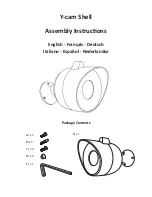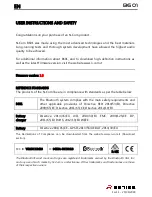
z
26
4.5 Water leakage sensor (optional)
The cookguard functions can optionally be
extended with up to four water leakage sensors.
If the sensors come into contact with water, a
water leakage alarm is triggered (Table 1). The
status LED flashes blue slowly accompanied by
an acoustic signal.
Procedure with water leakage sensor:
Press the operation button (3) to acknowl-
edge the water leakage alarm.
The acoustic signal and flashing status LED
(5) went out.
Switch off power supply.
Remove the cause of the water leakage.
Clean and dry water leakage sensor(s) with a
clean cloth.
Switch on power supply again and perform
functional test.
If the water leakage sensor remains wet, it
retriggers an alarm after 8 hours.
4.6 Potential-free contacts (optional)
The device has two potential-free contacts
AUX1 and AUX2 (figure 6) e.g. that a KNX radio
binary input can be connected to. In this way,
for example, an alarm signal can be sent to the
KNX bus. The alarm signal remains activated
until the alarm (see Hazardous situation, water
leakage) is acknowledged by pressing the
button (3) on the sensor unit. The wiring of the
potential-free contacts and their meaning is
shown in table 3.
In the normal mode of the AUX outputs, the
contact between
In
and
Out
is closed when ON
and opened when OFF.
The AUX output signal can also be reversed.
The reversed signal can, for example, be used
to detect a cable breakage or if the power
supply has been interrupted completely (see
Chapter 5.1 "Connect potential-free contacts")
In the inverted case, the contact between the
In and Out terminals in the OFF state is closed
and opened in the ON state.
If a KNX radio binary input is used, the
usage of reversing AUX signals may lead to
a reduction of the battery service life of the
radio binary input.
The AUX outputs can be connected in four
ways (Table 4).
Option 1
is to be used for
forwarding the alarm message.
AUX1
AUX 2 System status
OFF
OFF
No alarm message!
Cooker switched off or no hazardous situation
OFF
On
Cooking activity is detected.
This status is activated immediately after switching on the cooker. Depending
on the intensity of the cooking, the signal is switched off 1 ... 30 min after
finishing the cooking process. This delay time can be used to:
- switch on e.g. an extractor hood or kitchen exhaust using the signal that is
present.
- perform an evaluation, how often cooking occurs, with the signal change
from OFF → ON.















































